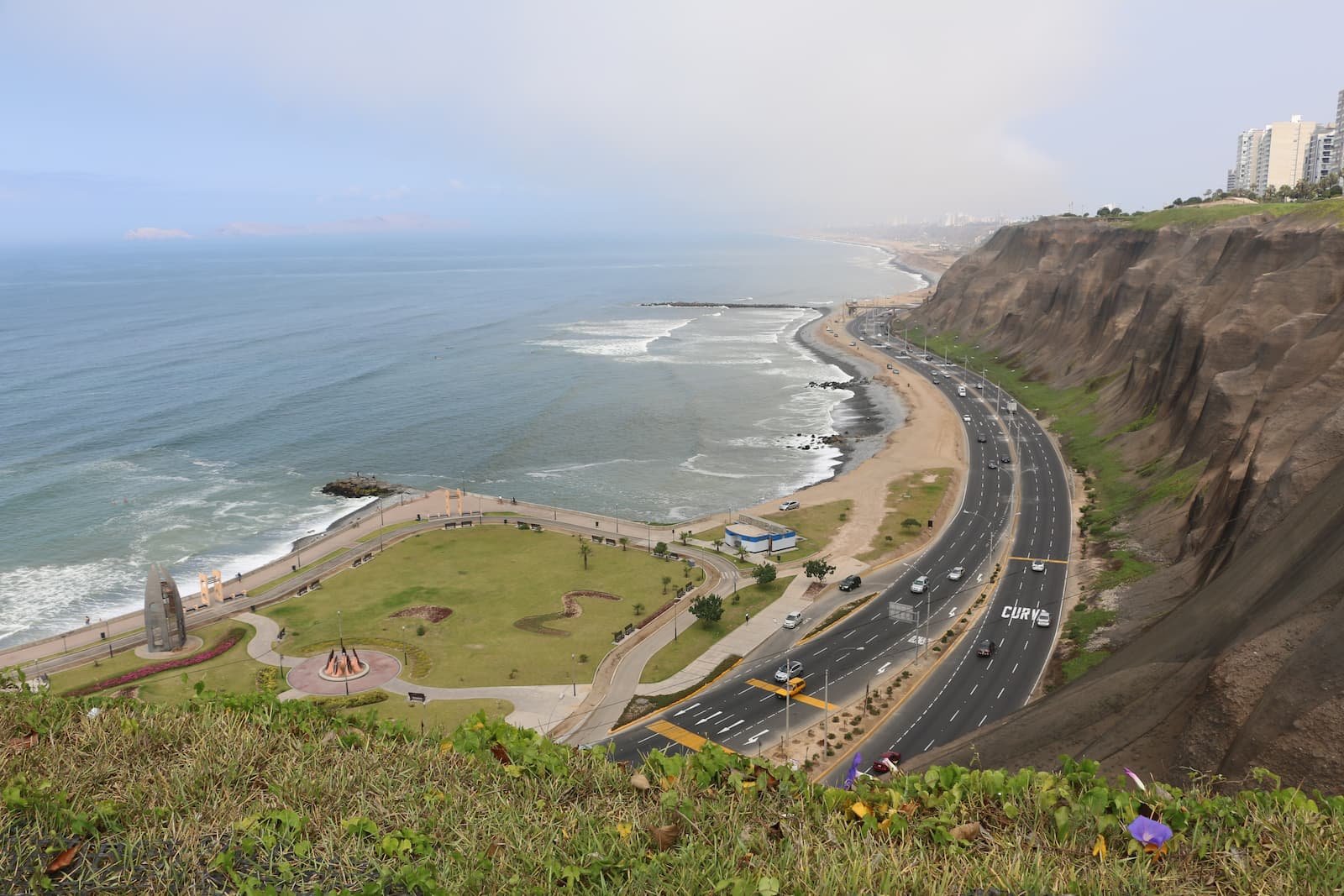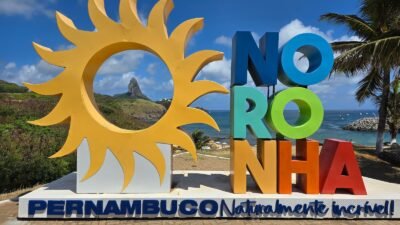Lima, the capital of Peru, is a city that blends gastronomy, archaeology, stunning landscapes, and monuments, along with the incredible Peruvian hospitality. All of this comes at a very reasonable price compared to European and North American destinations. Plus, getting to Lima is quite easy, with direct flights from the major North American and European airport hubs.
If you’re planning to visit Lima, check out these 18 tips to make your trip more productive and budget-friendly. These tips are essential for first-time visitors or those returning after a long time.
1. The best time to visit Lima

Lima is a tourist destination that can be visited at any time of the year. The city’s climate is desert-like, and it hardly ever rains in Lima. The average annual precipitation is around 200mm (source: Climate-Data.org)
The rainiest months in Lima are January, February, and March. In February, precipitation peaks at around 40mm—you might even be grateful if it rains! During the rest of the year, monthly precipitation remains around 10-15mm, which is very low.
Temperature-wise, it stays around 19°C (66°F), rising slightly from December to March and dropping a bit from May to November. In short, the weather is pleasant year-round, and if you’re near the Malecón de Miraflores, you’ll also enjoy a refreshing sea breeze.
As we’ll discuss next, traffic in Lima is intense and chaotic. According to local taxi drivers, a good time to visit is in the weeks leading up to Christmas in December, when many residents travel, reducing congestion.
However, if you also plan to visit Cusco and Machu Picchu, which have a very different climate, it’s best to go between April and September, the dry season in that region.
2. How to get to Lima
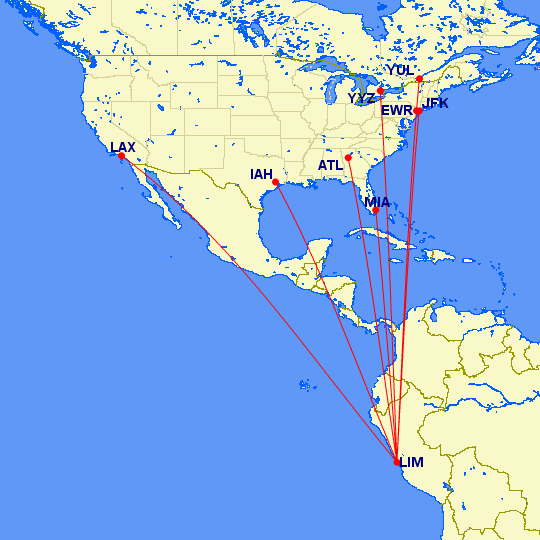
Lima and Cusco are the main air entry points to Peru. As mentioned earlier, there are direct flights from major North American and European airport hubs to Lima.
From the U.S., direct flights are available from Los Angeles (LATAM), Houston (United), Atlanta (Delta, LATAM), Miami (Latam, American), New York-JFK (LATAM), and Newark (United).
From Canada, passengers can fly directly from Montreal or Toronto with Air Transat.
Europeans, meanwhile, can fly from Amsterdam (KLM), Paris (Air France), and Madrid (Air Europa, LATAM, Iberia, Plus Ultra).
3. From Lima Airport to your hotel
The best option to get from Jorge Chávez International Airport (LIM) to your hotel’s neighborhood is to hire a taxi directly at the counters located at the airport exit.
Keep in mind that many of these authorized taxi counters are located before the exit doors of the restricted area, beyond which you cannot return.
Types of Taxis at Lima Airport. There are two types of taxis at Lima Airport: regular and VIP.
- Regular taxis are operated by TaxiGreen, Taxi360, and Taxi Directo.
- VIP taxis are provided by CMV and Trip, offering more luxurious vehicles (Mercedes, Lexus, among others).
We personally recommend Taxi Directo, as they offer more comfortable vehicles. Once you pay, an employee will quickly escort you to your car.
The fare depends on the vehicle size (and the number of passengers) and the neighborhood you are heading to. From the airport to Miraflores, a car for three passengers costs 60 soles (about $16 USD).
Is Uber Worth It from Lima Airport to the City? No. We noticed that Uber fares to and from the airport are often more expensive than the authorized taxis. Additionally, many Ubers we used in Lima were old and/or in a poor condition.
Alternative: Airport Lima Express. If you’re traveling alone and heading to Miraflores, a good option is the Airport Lima Express, a comfortable shuttle bus that connects the airport to the neighborhood.
- The regular fare is 20 soles (about $5.50 USD).
- There’s a discount if two or more passengers are traveling on the same flight.
The bus has four stops in Miraflores:
- Marriott (Larcomar Shopping Mall)
- Tourist Information Center (Av. José Larco)
- Parque Kennedy (Tourist Information Center)
- Hotel Boulevard (Av. José Pardo)
These stops are close to the main hotels and hostels in Miraflores. The neighborhood itself is relatively flat and pedestrian-friendly.
For more details, check the Airport Lima Express website.
Returning to the Airport. On the way back to the airport, I found it more convenient to take an Uber XL, but you can also ask your hotel to arrange a taxi for you.
Important Travel Tip: Lima’s Traffic. Due to heavy traffic in Lima, you should allow at least one hour to travel from Miraflores to the airport, especially on weekdays. Also, expect a high volume of vehicles at the airport entrance, which may take an additional 10 minutes to reach the drop-off point.
By planning ahead, you can ensure a smooth and hassle-free arrival and departure in Lima!
4. Where to stay in Lima?

In Lima, I recommend staying in three neighborhoods: Miraflores, Barranco, and San Isidro.
- Miraflores is the most famous neighborhood in Lima. It’s relatively safe and features a beautiful boardwalk with several parks along the coast. It has a wide variety of hotels, restaurants, shops, and shopping centers, such as Larcomar. It’s a great place to stay, as most tourist services (tours, buses, etc.) primarily cater to Miraflores guests. Explore accommodation options in Miraflores – click here.
- San Isidro is an upscale, residential neighborhood with many mansions, business buildings, and tree-lined streets. It’s a safe area in Lima, home to some embassies, a country club, important schools, and lovely public spaces, such as the Bosque El Olivar. The neighborhood is also known for its excellent restaurants (e.g., Astrid y Gastón). There are a few museums and an archaeological site (Huaca Hallamarma) as well. While it may not have as many tourist attractions, it’s definitely a pleasant place to stay. Explore accommodation options in San Isidro – click here
- Barranco is a bohemian and charming neighborhood known for its street art, live music, and restaurants. It tends to be crowded with tourists during the day and night. There are also viewpoints offering stunning views of the Pacific Ocean. The neighborhood was built in the 19th century as a beach destination for Lima’s aristocracy, with palm trees and colonial-style mansions. Many of these mansions now house shops, art galleries, or restaurants. If you’re looking for a more laid-back atmosphere, this is your place. Explore accommodation options in Barranco – click here
The question remains whether it’s worth staying in Lima’s Historic Center. Recognized as a UNESCO World Heritage Site, the center of Lima develops from the Plaza de Armas (Main Square), where the Lima Cathedral and Government Palace are located. Lima’s center is full of colonial buildings, museums, churches, historical monuments, and government offices. It’s a delight to walk around this area during the day and appreciate all the architectural beauty that’s been preserved.
However, there are few good hotel options in central Lima. Most of them are old, and tourists often complain about the noise. One advantage of staying in the center is the ease of access to attractions. Around Plaza de Armas, there are several pedestrian-only streets, which makes it much easier to get around on foot.
The big issue is what to do at night. For safety reasons, it’s not recommended to walk around the center at night. So, it’s up to you to decide!
5. How long should I stay in Lima?
As a general rule, large cities are full of tourist attractions. This holds true for almost all metropolises worldwide. Lima is no exception. There are countless museums, churches, squares, parks, and public spaces to visit and enjoy, along with incredible restaurants and shopping areas.
Therefore, it’s recommended to spend at least 5 days just in Lima.
If you want to take one or more day trips—and there are many interesting ones—add extra days to your stay in the Peruvian capital.
6. How to get around in Lima?
Traffic in Lima has become increasingly heavy and somewhat chaotic. When heading to attractions, appointments, or the airport, it’s essential to leave plenty of buffer time. When I visited Lima in December 2016, getting around was a bit easier. During my last trip (October 2023), we were surprised by heavy traffic throughout many parts of the city.
The public transportation system isn’t great. To get around the city, you’ll need to rely on taxis and ride-sharing apps (Uber, Cabify).
Walking is a good option for shorter distances. The city is relatively flat and pedestrian-friendly, with good sidewalks. However, you should be careful at crosswalks and intersections, as drivers tend to ignore pedestrian crossings without traffic lights.
7. Which areas should I avoid in Lima? What are the most dangerous neighborhoods in Lima?
Like any major city in Latin America, Lima also has dangerous neighborhoods that should be avoided, both for visiting and accommodation. These include San Juan de Lurigancho, San Juan de Miraflores, Villa El Salvador, Comas, Puente Piedra, and Villa María del Triunfo.
Tourists visiting Lima should avoid these neighborhoods, especially at night. Besides, there isn’t much to see or do in these areas anyway.
8. Arrive early at Lima Airport
Besides traffic, another reason to arrive early at Lima Airport is the high passenger volume, especially during weekdays.
We took a domestic flight on a Monday morning and encountered extremely long lines, both for check-in/baggage drop and security screening. For check-in and baggage drop, we used the dedicated counters for Latam loyalty program members (it’s a bit hidden, but just ask for it), which saved us considerable time. Unfortunately, we couldn’t avoid the security inspection line.
So, if you’re traveling in economy class and don’t have airline loyalty status, remember to arrive early to deal with the airport queues.
It’s important to note that Lima Airport has controlled access to the check-in area. Only passengers are allowed to enter. You must present your boarding pass or flight ticket to the security officers at the terminal entrance.
9. Aviation hub in Latin America
Lima is a major Latin American aviation hub for the LATAM group. To reach certain destinations in the Americas that don’t have direct flights (or only have limited and expensive options) from North America or Europe, you’ll likely need to connect through Lima.
These destinations include cities in Brazil, Ecuador, Bolivia, and Venezuela.
Since you’ll need to connect in Lima anyway, why not plan a stopover on your outbound or return journey?
Not only will this make your trip less tiring, but you’ll also get to experience this incredible destination that combines amazing cuisine, archaeological sites, and warm hospitality.
10. Malecón de Miraflores

The Miraflores waterfront is different from most coastal cities in the world. There’s a higher region with several parks and ‘Malecóns,’ a large cliff, and a lower area where an expressway (‘Circuito de las Playas’) runs. All of this is before reaching the beaches themselves, which are full of rocks.
In Spanish, “Malecón” has two meanings. It can refer to a wall built to protect from water, or a promenade that runs parallel to the sea or a river. The most famous Malecón is in Havana, Cuba.
Locals often walk, stroll, or run in the higher part of the city. The view from up there is breathtaking! And people really get into sports in Lima! In the lower part, you’ll find many cars parked and plenty of surfers tackling the cold waters of the Pacific Ocean.
One great thing about Miraflores is that all the parks and squares in this area are clean and well-maintained. Some parks even offer free internet access. Plus, there are flowers all along the way. Perhaps that’s where the name Miraflores comes from.
Visiting the Miraflores waterfront is a must for anyone visiting the Peruvian capital. The waterfront stretches about 4 km and can be walked in about an hour. Along the route, you’ll pass by these parks:
- Parque Malecón de la Marina,
- Parque Maria Reiche,
- Parque El Libro,
- Parque El Faro de la Marina, and
- Parque del Amor.
11. Squares, parks, and public spaces
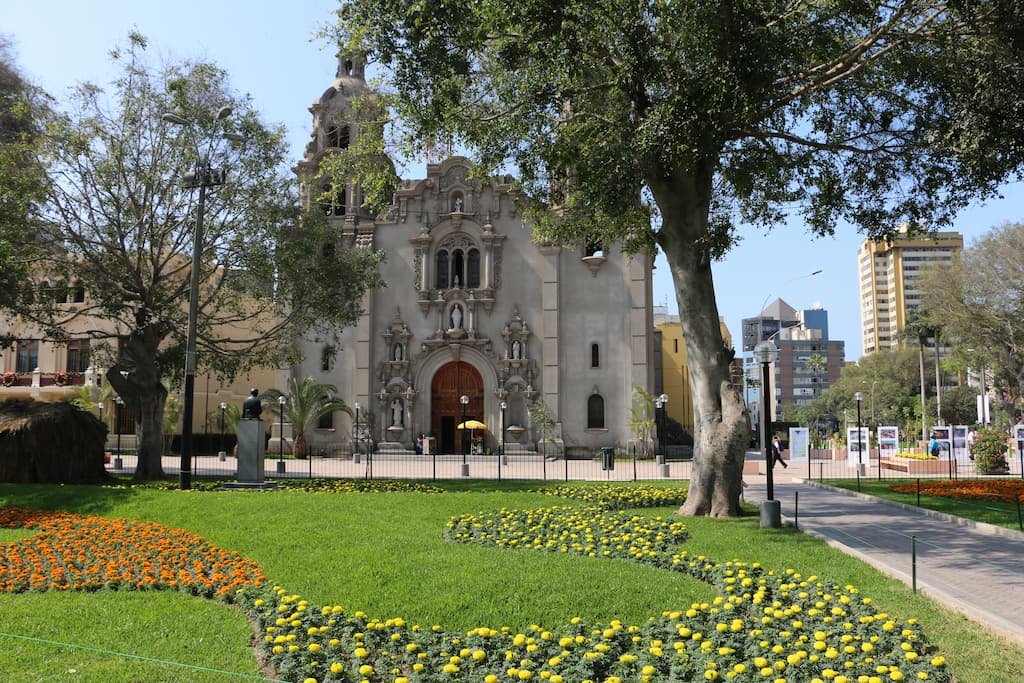
One thing that impressed me about Lima was the care the municipality takes with squares, parks, and other public spaces. They are clean, safe, with blooming gardens, and they attract many people, especially the locals.
The Malecón in Miraflores, with its many parks, is just one example. There are several others that I recommend visiting:
- Plaza Kennedy and Parque 7 de Junio (Miraflores)
- Parque and Bosque El Olivar (San Isidro)
- Parque Bicentenário (Miraflores)
- Campo de Marte (city center)
- Parque de la Reserva (home of the Circuito Mágico del Agua – paid)
- Parque de la Exposición (city center)
- Plaza de Armas (city center)
- Bajada de los Baños (Barranco)
These are vibrant places! In this regard, I think we have a lot to learn from the Peruvians.
12. Take a day to visit the Historic Center
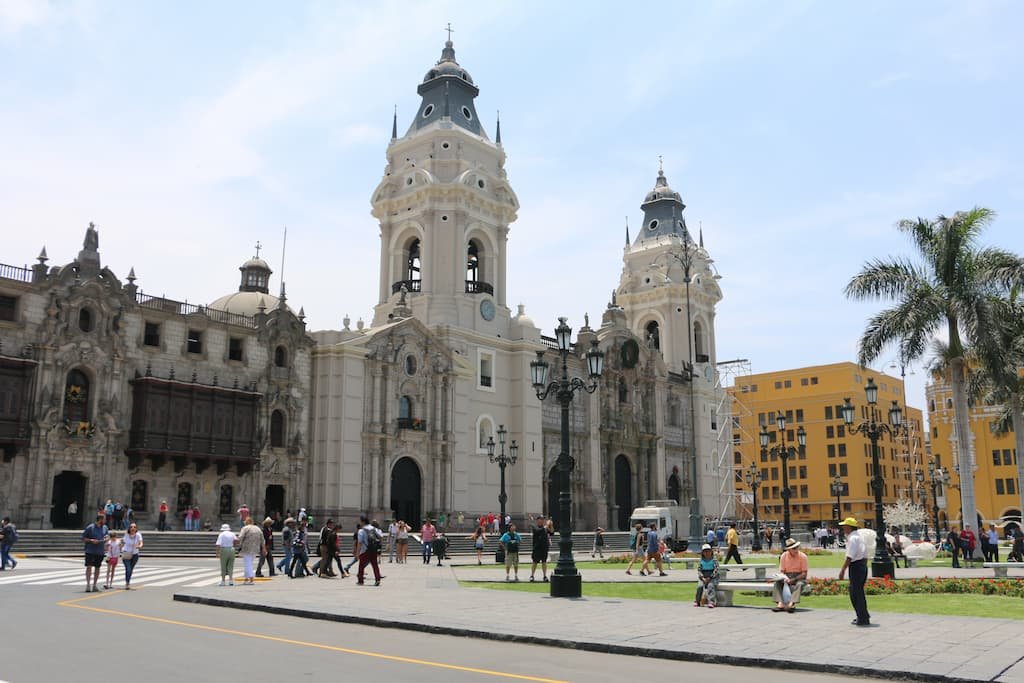
When planning your trip to Lima, be sure to take a day (or more) just to explore the historic center, also known as the civic center.
The historic center is the area around Plaza de Armas. It’s a region with well-preserved buildings and is pedestrian-friendly, featuring several walkways. It’s packed with attractions, such as the Cathedral of Lima, the Government Palaces, museums, churches, and other points of interest.
In addition to the tourist sites, the civic center has craft shops, souvenir stores, ice cream parlors, and pleasant restaurants for lunch.
A word of caution: Plaza de Armas is often closed by the police due to demonstrations and protests. The Presidential Palace is located in this square.
13. Barranco
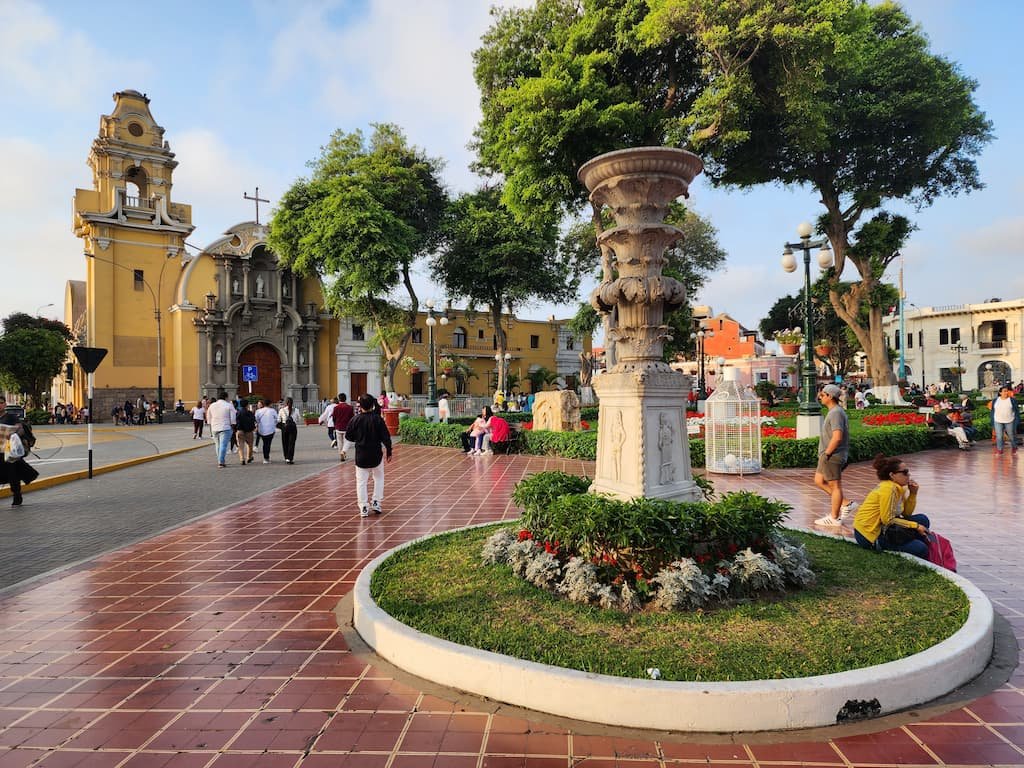
Barranco is one of the most charming and picturesque neighborhoods in Lima. It’s a bohemian district, just a stone’s throw from Miraflores, that blends art, culture, and history with a unique atmosphere that draws travelers from all over the world. Yes, you’ll meet people from everywhere in Barranco, and many visitors prefer to stay in the neighborhood’s hotels, inns, and hostels.
Here are some of the top attractions you can’t miss:
- Bridge of Sighs (Puente de los Suspiros): This is the icon of Barranco. A charming wooden bridge known as a romantic spot where couples often sigh in love. Legend has it that if you manage to cross it without breathing, your wish will come true. It’s worth a try!
- Barranco Municipal Park: A perfect place to relax and enjoy the lush greenery. It’s a popular spot for picnics and outdoor activities.
- Museum of Contemporary Art (MAC): If you’re an art enthusiast, don’t miss the MAC. The museum houses an impressive collection of both Peruvian and international contemporary art.
- Sáenz Peña Boulevard: A lively street full of restaurants, bars, and craft shops. It’s the perfect place to savor Peruvian cuisine and soak in the local vibe.
- Barranco Viewpoint: Head up to the viewpoint for breathtaking panoramic views of the ocean and the Barranco neighborhood. It’s a great spot for photos.
- Barranco Church: The church is a beautiful example of colonial Peruvian architecture and holds great historical significance in the region.
- Art Galleries and Studios: Barranco is known for its numerous art galleries and studios, where you can explore and purchase works by local artists.
- Cafes and Bars: Don’t miss out on Barranco’s nightlife. There’s a wide variety of bars and cafes offering live music and a laid-back atmosphere.
Barranco uniquely blends tradition and modernity. Stroll through its colorful streets, discover art at every corner, and enjoy delicious Peruvian food while immersing yourself in the bohemian atmosphere. Your visit to Barranco will surely be an unforgettable experience.
14. Archaeological sites in Lima

15. Circuito Mágico del Água

The Magic Water Circuit (Circuito Mágico del Água) is a beautiful park with water fountains located in Parque de la Reserva, in downtown Lima, next to the National Stadium of Peru. It’s guaranteed fun for both kids and adults!
The Magic Water Circuit was inaugurated in 2007 as part of a public space revitalization program in Lima. It features thirteen “cybernetic” fountains, which use technology to combine music, lighting, sound, and water to create a stunning spectacle for visitors. In addition to the cybernetic fountains, the park also has historical and cultural monuments, ornamental fountains, a birdwatching route, and beautiful gardens.
Parque de la Reserva, on the other hand, was opened in 1929 in honor of the reservists who fought to defend the city during the War of the Pacific (1881). Its design was inspired by European parks.
However, the highlight of the park is the water, light, and projection show that takes place at the Fountain of Fantasy (Fuente de la Fantasía). The show runs at scheduled times (7:15 PM, 8:15 PM, and 9:30 PM). Watch a sample of the show here, set to the music of Strength of a Thousand Men. It’s impressive and truly indescribable!
16. Visit Larco Museum

The Rafael Larco Herrera Archaeological Museum, also known as the Larco Museum (Museo Larco), is a private museum dedicated to pre-Columbian artifacts. Without a doubt, it’s the top museum in Lima! I highly recommend visiting it!
Rafael Larco Hoyle is considered one of the fathers of Peruvian archaeology. He dedicated his life to studying the treasures of ancient Peru, conducted stratigraphic studies, and wrote several scientific texts on the subject.
- Just for curiosity: Rafael Larco Herrera, after whom the museum is named, was the father of Rafael Larco Hoyle. Herrera was the first vice-president of Peru (1939–1945), as well as minister of Foreign Relations (1931). The archaeologist’s collection of objects was named in honor of Herrera for his love of the country.
The museum is housed in an 18th-century building built atop a pre-Columbian pyramid. The Spanish often did this to indicate that their culture or religion was superior to that of the natives. This was the case, for example, with the Metropolitan Cathedral of Mexico City.
Pre-Columbian civilizations are not limited to the Inca civilization. While the Inca are the most well-known and dominated the region for only 150 years before the Spanish arrived, the civilization actually began there 5,000 years ago.
If you have to choose just one museum to visit in Lima, pick the Larco Museum. It’s very educational! I recommend spending 3 to 4 hours there to fully explore it.
17. Destinations around Lima
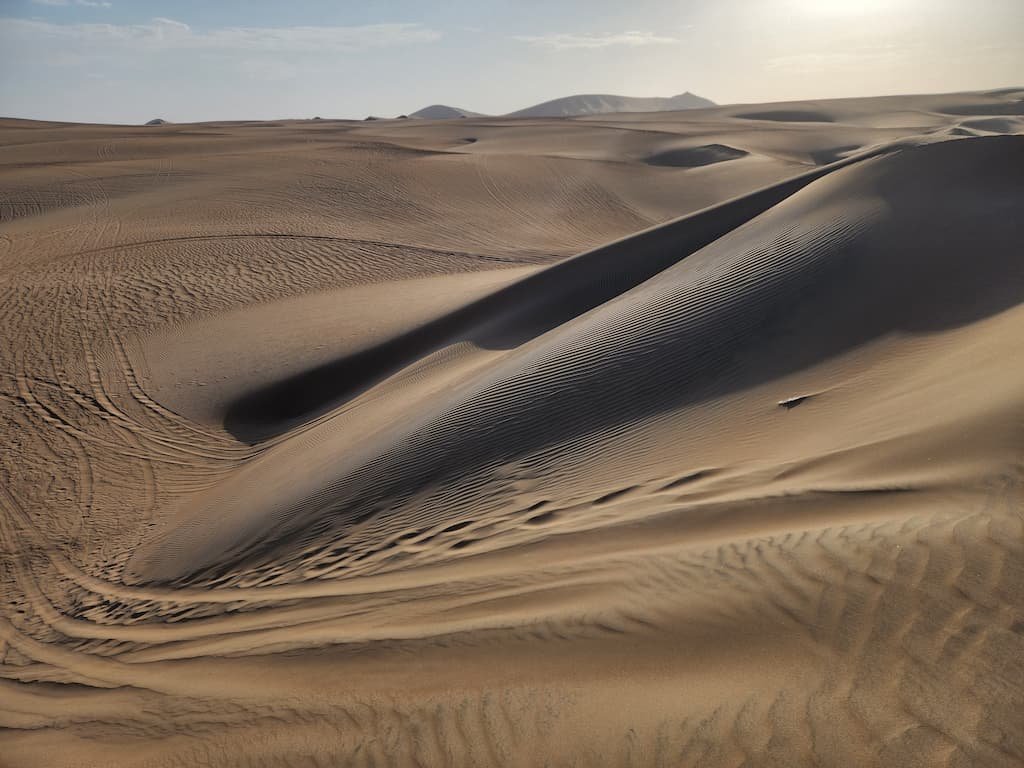
There are many tourist attractions around Lima. These can be visited on one- or multi-day trips, which are available through various local travel agencies.
Day trips are convenient for those with limited time who prefer to stay based in the Peruvian capital. For more distant locations (such as Nazca), you should consider whether it’s better to do a multi-day tour of Peru (changing bases) rather than taking 2-, 3-, or 4-day excursions.
By the way, we took a 2-day tour to various locations with PeruHop. It’s a travel company we recommend. While the tour includes some very interesting places, the 2-day trip can be a bit tiring. On the second day, we spent a lot of time on the bus.
Here are some destination and tour options around Lima:
- Pachacamac: A major pre-Inca archaeological site located about 30 km south of Lima, Peru. It was one of the main ceremonial centers of the Peruvian coast between the 13th and 15th centuries. The site consists of pyramids, plazas, and temples built with adobe and bricks. It was dedicated to the god Pachacamac, an important deity of the Peruvian coast. Pachacamac retained its significance even after the Inca and Spanish conquests.
- Palomino Islands: Known as Lima’s Little Galapagos, the Palomino Islands are home to about 8,000 sea lions. You can take a 45-minute taxi ride from Lima’s historic center or Miraflores to the Callao port, followed by a 10 km boat ride to the islands.
- Lomas de Lucumo: This 150-hectare oasis of rolling hills becomes lush with vegetation during the winter months (June to October). You can follow the two main trails on your own or hire a guide at the base of the attraction.
- Caral: An archaeological site that predates the Inca civilization by 4,000 years and was built around the same time as the Egyptian pyramids. It’s located about 3 hours by car from Lima.
- Ballestas Islands: An archipelago located on the coast of Peru, in Paracas, about 3 hours south of Lima by car. They are often compared to the Galapagos Islands due to the wildlife they host. The islands are home to a large colony of sea lions, Humboldt penguins, and other seabirds. Visitors can enjoy close-up views of this wildlife on boat tours from the Paracas port. It’s a great day-trip option from Lima to observe wild animals in their natural habitat.
- Huacachina: A small, charming desert village located about 5 hours south of Lima. It is considered the only oasis in South America’s desert. The village surrounds a freshwater lagoon, encircled by sand dunes. It’s a popular destination for those seeking adventure and fun in the desert. Available activities include dune buggy rides, sandboarding, and boat tours on the lagoon. Huacachina also offers beautiful desert sunsets and charming accommodations.
- Nazca Lines: A series of geoglyphs (designs in the ground) located in the Peruvian desert, about 400 km south of Lima. They were created between 500 BC and 500 AD by the Nazca people, covering an area of over 500 km². There are hundreds of figures, including depictions of animals, plants, and geometric shapes, some as wide as 200 meters. To view them, you can book a scenic flight from the Nazca airport or observe them from a viewpoint located on the Pan-American Highway.
18. Apreciate peruvian gastronomy

Lima is the gastronomic capital of South America, and Peruvian cuisine is considered one of the richest in the world. Among the main dishes, appetizers, desserts, and traditional drinks, we can highlight:
- Ceviche – Raw fish marinated in lime juice, with onion, chili, and cilantro.
- Causa – Mashed potatoes seasoned with lime, olive oil, and yellow chili, stuffed with chicken, tuna, or shrimp.
- Lomo Saltado – Sliced steak in a tomato sauce with onion, french fries, and rice.
- Anticuchos – Grilled beef heart skewers.
- Ají de Gallina – Shredded chicken in a yellow chili sauce with cheese.
- Arroz Chaufa – Stir-fried rice with eggs, meats, and vegetables.
- Suspiro a la Limeña – A creamy dessert with dulce de leche and meringue.
- Pisco Sour – A cocktail made with pisco, lime, egg white, sugar, and Angostura.
- Chicha Morada – A drink made from purple corn with spices and fruit.
In the Peruvian capital, you can find everything from traditional dishes to contemporary creations by renowned chefs who blend local ingredients with modern techniques.
You can have a culinary-focused tourist experience in Lima. For example, in 5 days, you can visit 10 different restaurants.
Personally, I really enjoy Lomo Saltado, Causas, and Ají de Gallina Risotto. For dessert, Suspiro a la Limeña is a must. I’m not a big fan of Peruvian wines, but on hot days, I never pass up a Cusqueña Dorada, a simply delicious Peruvian beer.
Many restaurants in Lima offer affordable lunch menus. In the city center, you’ll find several of them.
Did you like our Lima Travel Tips? Check out all our travel articles in English by clicking here.
